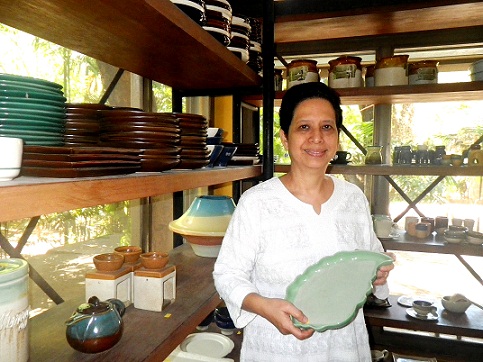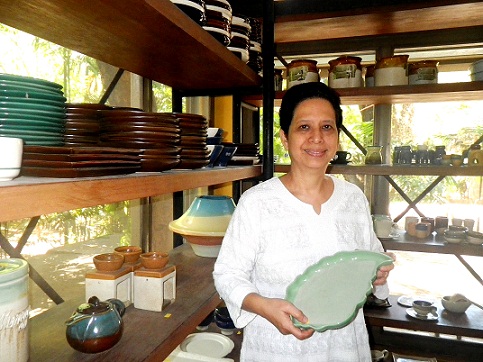By NORMAN SISON
ART cannot be rushed. It has its own pace. Rush it and its excellence is lost along the way — or so goes the conventional concept in the never-ending art-versus-commercialism debate.
That is why some people tend to think that paintings being sold by painters trying to make a living by being artists aren’t really art. Cheap art, if at all. In the financial pressure to make money, as the conventional thinking goes, artistic excellence becomes secondary.
But ceramic potter Lanelle Abueva-Fernando doesn’t see it that way. Commercialism doesn’t bother her because that’s the path she chose when she took up pottery in the 1970s during a three-year stay in Japan.
“What I like about pottery is that I can create functional pieces,” she says. “I make more functional pieces than artistic pieces.”
Fernando is an artist, first and foremost. She took up fine arts at the University of the Philippines, where her father Jose Abueva was its 16th president. She is the niece of National Artist for sculpture Napoleon Abueva.
She has participated in exhibits and occasionally holds pottery workshops at her cafe in Antipolo City. But she is realistic and recognizes that purely artistic pursuits would be close to making a vow of poverty. “I cannot pay my 13 workers if I am not in commercialism,” says Fernando. She runs a cafe in Antipolo but she focuses more on her ceramic business, which she started in 1981.
What Fernando does, however, is add artistry to what for ordinary people are everyday objects, such as plates and cups. If you are going to make plates, why not make them as artistic as possible? After all, art’s beauty is in the eye of the beholder.
A case in point is Fernando’s 52-seat, reservation-only Crescent Moon Cafe, one of Antipolo City’s few well known dining locations. All the ceramic plates, platters, cups and saucers, and other tableware in the cafe are Fernando’s creations.
If you want buy some of her works, in a corner of the cafe are ceramic tableware, oil burners, oil and lotion bottles, pitchers, trays, tea sets, vases and other works stacked on wooden shelves for sale.
Actually, people don’t need to visit the cafe to eat off Fernando’s plates. She receives orders for ceramics from hotels, restaurants, cafes, resorts and spas here and abroad every other day. Hotel guests may be unaware that they are dining on Fernando’s plates. The Spa, one of the Philippines’ best known spas, gets oil burners from her.
Fernando’s cafe is in a 3,000-square meter property, about 260 meters from the main road connecting Manila to Antipolo.
The town is home to a statue of the Virgin Mary, venerated as Nuestra Señora de la Paz y Buen Viaje (Our Lady of Peace and Good Voyage), which came from Mexico on a galleon in the 1600s.
Antipolo’s hills and cool climate makes it an ideal location for religious retreats, convention centers and a weekend escape for Metro Manila residents taking refuge from the tropical heat.
Crescent Moon Cafe is an oasis of quiet. The lush of trees and plants provide a refuge from the rumble of tricycles that infest the city. Adding to the tranquility is a fountain that gently splashes into a pool in which large koi and Japanese carp glide leisurely.
 Also in the compound is Fernando’s workshop, just inside the gate. Stacked all over the place are ceramic pieces in various stages of production. Two workers are busy making pottery while another carefully places completed pieces in a gas-fired kiln for a 12-hour baking.
Also in the compound is Fernando’s workshop, just inside the gate. Stacked all over the place are ceramic pieces in various stages of production. Two workers are busy making pottery while another carefully places completed pieces in a gas-fired kiln for a 12-hour baking.
Many of Fernando’s creations are fusions of Asian and Western cultures because she studied abroad when she accompanied her father on his teaching stints in Japan, Nepal and the United States.
It was on the island of Hachijo-jima, 287 kilometers south of Tokyo in the Philippine Sea, where she learned the craft under the strict discipline of a Japanese master potter. Fernando took up further studies at the Sun Valley Center for the Arts in Idaho, USA.
The fact that all of Fernando’s pieces are hand-made already makes them works of art. That is a point that she drives home with her creations as she and other Filipino potters face competition from China.
Chinese factories use machines to mass produce ceramics. There are even machines that can manufacture stoneware that looks hand-made, Fernando says. There is no way one can manually compete against machines.
“The Chinese will even copy what you make, because there are consultants there who are Filipinos. They come here and take photos of my work, and they’re even proud to say that they are consultants for ceramic companies in China. It kills the traditional hand-made stuff,” Fernando adds incredulously.
Machines can churn out objects that look nice, but they cannot be called works of art. Objects made by hand have that personal touch from the artisan that only the human eye can see and appreciate. Machines have no such personal connection.
Thankfully, people still see the beauty of things made by hand. “There is a niche market that understands hand-made stuff,” says Fernando.
That is one reason why the conventional thinking in the art-versus-commercialism debate cannot be set in stone.
